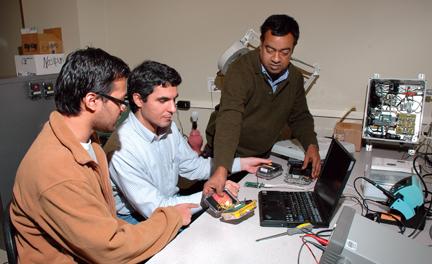Wireless Sensor Networks

Through wireless sensor networks that can be deployed quickly and safely, Lee College of Engineering researchers are helping keep power plants running through the continuous monitoring of vital equipment and systems.
The research is being led by Electrical and Computer Engineering professor Dr. Asis Nasipuri. Since 2006, Dr. Nasipuri has been working with the support of nearly $300,000 in grants from the Electric Power Research Institute (EPRI) on the wireless monitoring program.
“EPRI is leading a number of collaborative research programs that benefit the utility industry,” Dr. Nasipuri said. “It is interested in developing this wireless monitoring capability, because with no wires it can be deployed quickly, has flexibility, can continuously monitor multiple systems, and offers programmability that makes it smarter and faster than wired or manual monitoring systems.”
In developing the wireless systems, Dr. Nasipuri and his students are building small wireless sensor nodes that can be magnetically attached to power plant and substation equipment. The abilities of the nodes depend on their purpose, and can include the monitoring of temperature, vibrations and noise. Deployment of the nodes for detecting equipment faults can be permanent or temporary depending on the specific needs of the end-user.
“We do all of the engineering to get the functionality we need from the nodes,” Dr. Nasipuri said. “This includes building nodes that run on solar power for outdoor use, and building nodes with batteries that can last up to a year for indoor use.”
In addition to the remote monitoring nodes, the researchers have built a smart node that works as a base station. It collects all the information from the other nodes, and then through a cellular connection sends it to a laboratory on the UNC Charlotte campus for analysis.
The first field deployment of the wireless sensors was at the Paradise Substation operated by the Tennessee Valley Authority in Kentucky. The network contains 75 wireless sensor nodes that monitor the physical condition of the power transformers, circuit breakers, compressors and various other critical equipment.
The second deployment was at the coal-fired Gaston Power Plant in Birmingham, Alabama, for the Southern Company. All of the indoor plant equipment in an area obstructed by steel and concrete presented a special challenge for the wireless nodes.
“A key challenge is maintaining connectivity, because of the metal mass inside the plant,” Dr. Nasipuri said. “We built the system as an ad-hoc network, in which the nodes autonomously configure themselves into a mesh network and continuously adapt to variations of link quality and node availability. It has worked well. Our next goal is to expand it to 150 nodes at the substation without having to do any partitioning of the network.”
Another future goal of the research is to extend the capabilities of the nodes by incorporating more powerful processing. These new nodes will be capable of sensing very high frequency signals from equipment. “One of the objectives of these new nodes is to monitor transformer bushings,” Dr. Nasipuri said. “Bushing failures happen fairly often and are one of main causes of breakages. We will be trying out one of these new nodes at the TVA’s Concord Substation in Tennessee.”
For more information, contact Dr. Nasipuri at anasipur@uncc.edu
Dr. Asis Nasipuri, standing, and ECE graduate students Rohit Kale, left, and Hadi Alasti work with a wireless sensing node that can monitor temperature, sound and vibration. A close-up of one of the nodes is pictured below.